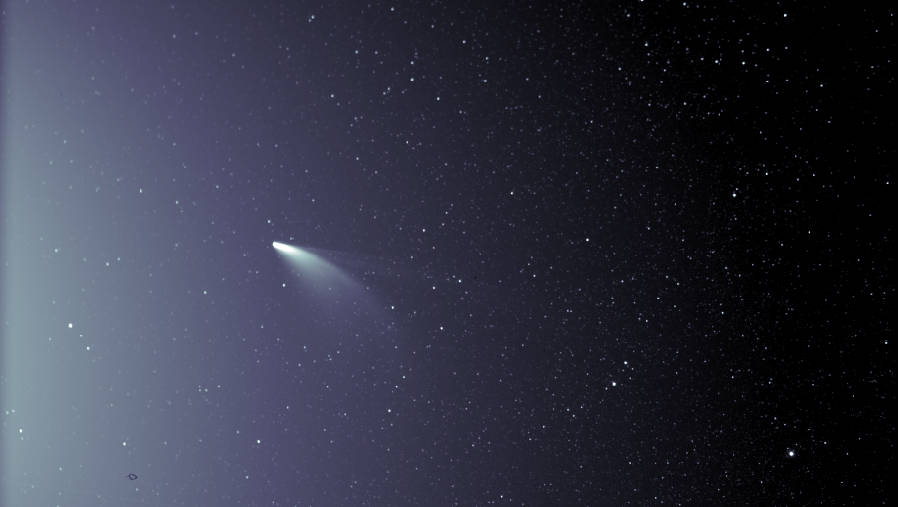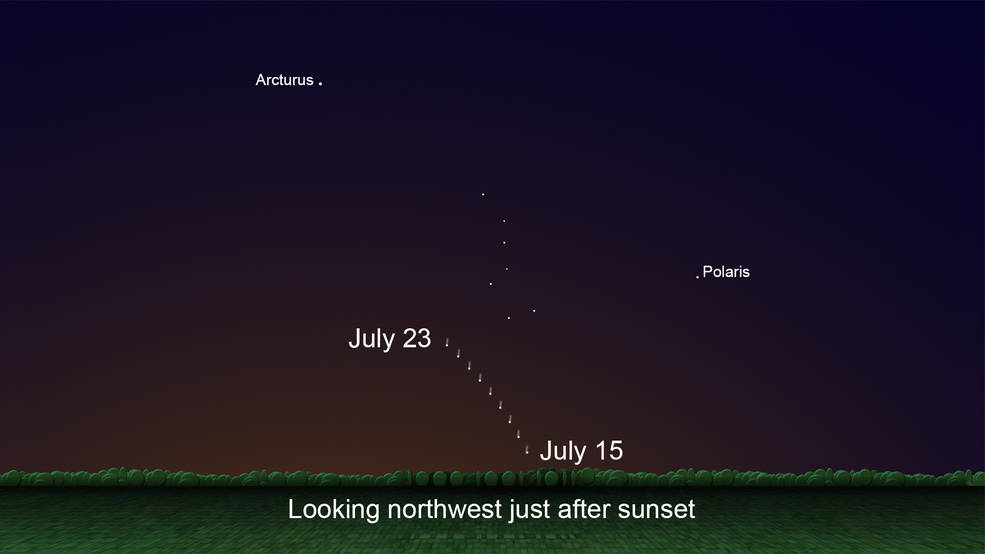__________________________________________________________

An unprocessed image from the WISPR instrument on board NASA’s Parker Solar Probe shows comet NEOWISE on July 5, 2020, shortly after its closest approach to the Sun. The Sun is out of frame to the left. The faint grid pattern near the center of the image is an artifact of the way the image is created. The small black structure near the lower left of the image is caused by a grain of dust resting on the imager’s lens. Credits: NASA/Johns Hopkins APL/Naval Research Lab/Parker Solar Probe/Brendan Gallagher
How to see comet NEOWISE
NASA
(July 14, 2020)
Observers in the Northern Hemisphere are hoping to catch a glimpse of Comet NEOWISE as it zips through the inner solar system before it speeds away into the depths of space. Discovered on March 27, 2020 by NASA’s Near-Earth Object Wide-field Infrared Survey Explorer (NEOWISE) mission, Comet NEOWISE is putting on a dazzling display for skywatchers before it disappears, not to be seen again for another 6,800 years.
For those hoping to catch a glimpse of Comet NEOWISE before it’s gone, there are several observing opportunities over the coming days when it will become increasingly visible shortly after sunset in the northwest sky. If you’re looking at the sky without the help of observation tools, Comet NEOWISE will likely look like a fuzzy star with a bit of a tail, so using binoculars or a small telescope is recommended to get the best views of this object.
For those hoping to see Comet Neowise for themselves, here’s what to do:
- Find a spot away from city lights with an unobstructed view of the sky
- Just after sunset, look below the Big Dipper in the northwest sky
- If you have them, bring binoculars or a small telescope to get the best views of this dazzling display
Each night, the comet will continue rising increasingly higher above the northwestern horizon as illustrated in the below graphic:

Skychart showing the location of Comet C/2020 F3 just after sunset, July 15 through 23. Credits: NASA/JPL-Caltech
Additional resources:
Read these skywatching Tips from NASA: https://solarsystem.nasa.gov/whats-up-skywatching-tips-from-nasa/
Learn these tips and trick on how to photograph comets and meteor showers: https://solarsystem.nasa.gov/news/510/how-to-photograph-a-meteor-shower/
Take a look at these images of Comet NEOWISE captured by NASA missions:
- Parker Solar Probe: /feature/goddard/2020/nasa-s-parker-solar-probe-spies-newly-discovered-comet-neowise
- International Space Station: /image-feature/comet-neowise-from-the-international-space-station and /image-feature/comet-neowise
- ESA and NASA’s Solar and Heliospheric Observatory: https://svs.gsfc.nasa.gov/13661
Explore various comet lessons and activities for educators and students:
Learn more about NASA’s (NEOWISE) mission that discovered Comet NEOWISE: https://www.nasa.gov/feature/jpl/comet-neowise-sizzles-as-it-slides-by-the-sun-providing-a-treat-for-observers
Brush up on comet science and learn how NASA studies these celestial objects: https://solarsystem.nasa.gov/asteroids-comets-and-meteors/comets/overview
Learn more about comet science, how Comet NEOWISE was discovered, and how you can spot it in the sky in this episode of NASA Science Live:
From NASA: Last Updated: July 16, 2020 — Editor: Emily Furfaro.
